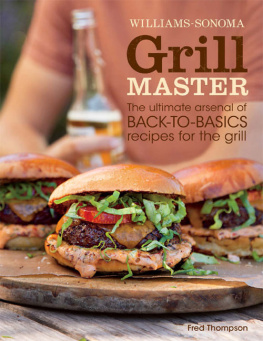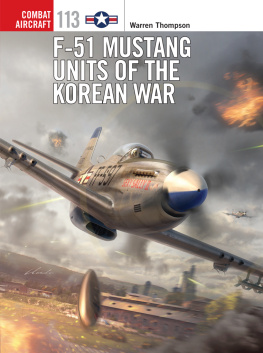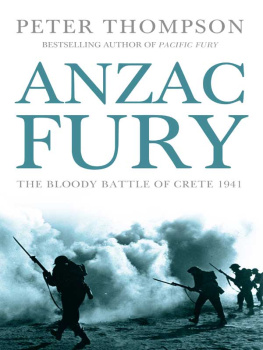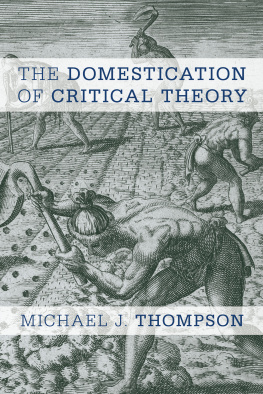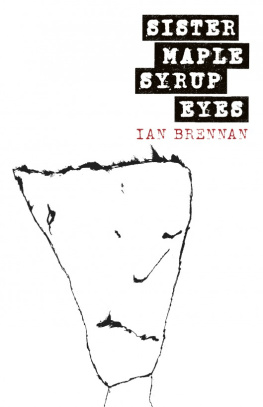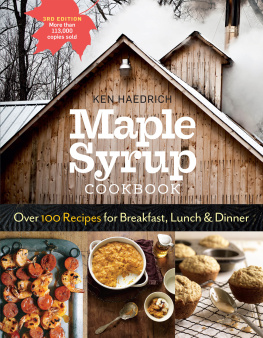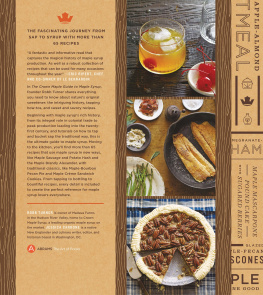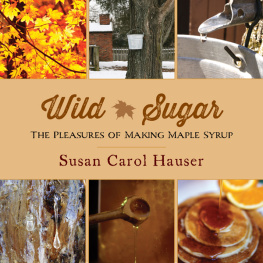Copyright 2003 by Jennifer Trainer Thompson
Photographs copyright 2003 by Jonathan Chester
All rights reserved. Published in the United States by Celestial Arts, an imprint of the Crown Publishing Group, a division of Random House, Inc., New York.
www.crownpublishing.com
www.tenspeed.com
Celestial Arts and the Celestial Arts colophon are registered trademarks of Random House, Inc.
Library of Congress Cataloging-in-Publication Data
Thompson, Jennifer Trainer.
Very maple syrup / Jennifer Trainer Thompson.
p. cm.
1. Cookery (Maple sugar and syrup) 2. Maple syrup I. Title.
TX767.M3.T48 2003
641.6364dc21 2003013314
eISBN: 978-0-307-78883-2
v3.1
Acknowledgments
Id like to thank Lynn Danahy, Jim Starke,
Jody Fijal, Cathy Greenwald, Jeannie and David Aplin,
and especially Linda Stripp for their assistance with this book.
Contents
The gift of the sugar maple trees is from a benevolent Providence.
Benjamin Rush (a signer of
the Declaration of Independence),
in a letter to Thomas Jefferson
Introduction
Its early March in New England, and while the nights are still cold and frosty, the days are warm enough that you can feel the suns feeble heat. That give and take of cold nights and warm days creates a suction of sorts in maple trees that causes the sap to rise and flow and yield its sweet water. There arent any buds on the trees yet, but Yankees know the first sign of spring: galvanized buckets hanging from maple trees along the side of the road.
When I was a kid, we cooked down our own maple syrup in the woods behind the Orchard School (forty gallons of sap to make one gallon of syrup), and that event became a cherished childhood school memory. More recently, when I enrolled our son in nursery school in the Berkshire Hills of northwestern Massachusetts, it wasnt the terrific program, or the brightly colored classroom, or even the wonderful teachers that sold me: it was the fact that the kids went into the woods, tapped the trees, and made their own maple syrup. My son came home from school thrilled the day he got to taste the sap dripping from the spigot; he was startled by how clear it was (like water), and how mild the sweetness. Pancakes have been a Saturday-morning ritual ever since.
While sweeteners have been around for at least three thousand years, it was the Native Americans who discovered that sugar could be tapped from trees. Long before Europeans arrived in North America, Native Americans were collecting tree water from maple trees and cooking it down over an open fire. Once they boiled the excess water from the sap, the remaining maple sugar was stored in cakes for the entire year. The Algonquin name for maple sugar is Sinsibuckwud (drawn from the wood), while the Ojibway called it sheesheegummavvis (sap flows fast).
The Native Americans taught the Pilgrims and early settlers throughout New England and Canada how to tap trees and make maple syrup. Indeed, maple syrup was part of the menu at the 1621 Thanksgiving in Plymouth. The Iroquois even celebrated the spring with maple moon or sugar month religious festivals that involved a maple dance performed when trees were tapped.
Maple sugar and maple syrup were supplemented by sugar refined from sugarcane during the 1600s, and sugar production was the biggest and most lucrative industry in the Caribbean and Central America. By the late 1600s, Europeans and people in the new colonies were drinking coffee and tea regularly, which led to increased demand for sugar. Throughout the 1600s, tremendous numbers of Africans were enslaved and brought to the Caribbean islands to work the sugar, tobacco, and cotton plantations, and the sugar islands of the Caribbean brought vast wealth to the French and English. As the slave trade grew, so did the antislavery movement. Interestingly, the movement to abolish the slave trade led to increased maple syrup production, which was an alternative to refined sugar. The March Farmers Almanack of 1803, for example, admonished farmers to prepare for making maple sugar, which is more pleasant and patriotic than that ground by the hand of slavery, and boiled down by the heat of misery. During the Civil War, maple syrup production became a matter of patriotism; not only did soldiers need food that wouldnt spoil during shipment and storage, but the use of maple sugar to sweeten ones foods was regarded as an act of protest by Northerners, since all the cane sugar and most of the molasses was produced in the South.
Today, most maple syrupstill a spring tradition steeped in ritual and romanceis produced in Vermont, New York, Ohio, Michigan, Pennsylvania, New Hampshire, and Canada. You wont find maple sugaring below 35 degrees latitude or west of 95 degrees longitude. Weather is the most significant role in sap production, with farmers relying on freezing nights and thaws during the day, which occurs anywhere from late February to early April. The sugar content of the sap is higher in a sugar maple than any other type of maple, and better tasting, according to many.
The federal government grades the syrup by color and flavor: grade A light amber, grade A medium amber, grade A dark amber, and grade B. Which is best is a matter of taste. In general, the lighter the color, the more delicate the flavor. First-run sap, which is produced early in the season, tends to yield a light, delicate syrup. The first run. wrote naturalist John Burroughs, like first love, is always the best, always the fullest, always the sweetest; while there is a purity and delicacy of flavor about the sugar that far surpasses any subsequent yield.
If youd like to try your hand at maple sugaring, the following sources can help; Making Maple Syrup by Noel Perrin. The Maple Sugar Book by Helen and Scott Nearing, the website of the Cornell Sugar Maple Research and Extension Program (http://maple.dnr.cornell.edu/produc/FAQIndex.asp), and the North American Maple Syrup Producers Manual (ohioline.ag.ohio-state.edu). If you just want to enjoy the flavor, the following recipes offer a variety of ways to use pure maple syrup.
The maple-tree yield a Sap,
which has a much pleasanter taste than the best Limonade or Cherry-water, and makes the wholesomest drink in the World.
Louis, Baron de La Hontan, 1703

Salads and Starters
Roasted Butternut Squash Bisque with Maple Crme Frache
Adding a teaspoon of curry powder to the onions while they are sauting gives this warming winter soup an interesting twist.
cup crme frache
1 tablespoon maple syrup
1 teaspoons kosher salt
2 tablespoons unsalted butter
1 cup finely chopped yellow onions
1 clove garlic, minced
1 butternut squash, peeled, seeded, and cut into 1-inch cubes (about 6 cups)
2 tablespoons canola oil
3 cups vegetable stock or chicken stock
1 cup heavy cream
Preheat the oven to 425F. In a small bowl, mix the crme frache, maple syrup, and teaspoon of the salt together until blended.
In large soup pot, melt the butter over medium heat. Add the onion and garlic. Saut for 5 minutes, or until golden. Set aside.
In a bowl, combine the butternut squash, oil, and the remaining 1 teaspoon salt. Toss to coat evenly. Spread on a baking sheet and roast for 20 minutes, or until easily pierced with a fork. Remove from the oven and add to the soup pot. Add the vegetable stock and cook over medium heat for 20 minutes or until tender. Remove from the heat and let cool slightly. Add the heavy cream. Pure in a blender in several batches. Return to the pot and gently reheat. Ladle into bowls. Top each serving with 1 tablespoon maple crme frache and serve hot.


